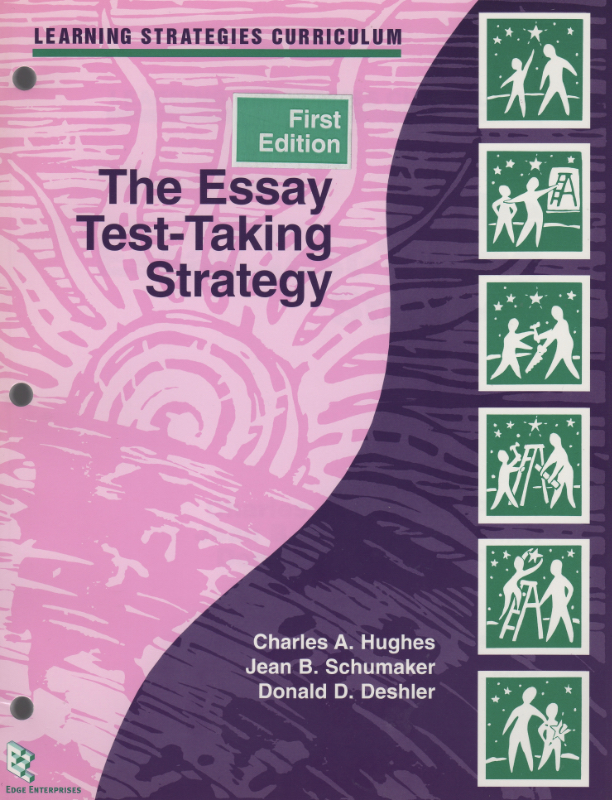The Essay Test-Taking Strategy

The Essay Test-Taking Strategy is designed to help students deal effectively with the complex test-taking demands of courses in school as well as the essay test-taking demands associated with state competency tests--including high-stakes tests--and college entrance exams. Students are taught to analyze essay questions, organize information, write their answers with a specific structure, and revise with edits to create polished products.
In studies, at-risk students who received instruction in the strategy earned an average score of 5 percent of the points available for essay test-taking behaviors before instruction. After instruction, they earned an average score of 85 percent of the points available. In addition, essay answers produced after instruction received higher ratings than those produced before instruction.
Author(s):Charles A. Hughes, Jean B. Schumaker, and Donald D. Deshler
Publication Info: Edge Enterprises, 2005
Resources:
Research Articles:
- *Woods-Groves, S., Alqahtani, S. S., Balint-Langel, K. & Kern, A. (2018). Electronic essay writing with postsecondary students with intellectual and developmental disabilities. Education and Training in Autism and Developmental Disabilities.
- *Woods-Grove, S., et. al, (2014). An Investigation of Strategic Writing Instruction for Post-Secondary Students with Developmental Disabilities. Education and Training in Autism and Developmental Disabilities.
- *Woods-Groves, S., Therrien, W. J., Hua, Y., & Hendrickson, J. M. (2013). Essay-Writing Strategy for Students Enrolled in a Postsecondary Program for Individuals With Developmental Disabilities. Remedial and Special Education, 34(3), 131-141.
- Woods-Groves, S., Hughes, C.A., Therrien, W. J., Hua, Y., Hendrickson, J., & Shaw, J. (2012). Effectiveness of an essay writing strategy for post-secondary students with developmental disabilities. Education and Training in Autism and Developmental Disabilities. 47, 2, 210-22.
- Therrien, W.J., Hughes, C.A., Kapelski, C., & Mokhtari, K. (2009). Effectiveness of an essay test-taking strategy on students with learning disabilities performance on persuasive essays. Journal of Learning Disabilities, 42 (1). 14-24.
The Story Behind the Essay Test-Taking Strategy from author Charlie Hughes:
We (Don Deshler, Jean Schumaker, Cecil Mercer, and I) included some instruction about answering essay questions in the instruction associated with the Test-Taking Strategy. However, this instruction was admittedly a fairly cursory covering of this topic. About a decade after the Test-Taking Strategy was developed, we observed that more and more testing situations required students to answer essay questions. Moreover, not only were essay questions present on classroom tests, they were also required in other assessment situations, such as state competency exams, high-stakes assessments, and the SAT college entrance exam.
We decided that answering essay questions was now worthy of its own strategy. The Essay Test-Taking Strategy emphasizes procedures to help students understand the questions or prompts (i.e., what is being asked, what are the requirements of the response), organizing their responses before they write (i.e., developing an outline), and then using the outline and their understanding of the question to write a well-organized and detailed response. We recognized that many students other than those with LD could benefit from this strategy as well as the fact that many students with LD receive most of their instruction in the general education classroom. Therefore, we developed the manual to be somewhat different from the previously developed strategies manuals. We used a “lesson” format which is familiar to general education teachers, and we provided a variety of options related to the instructional procedures, recognizing some students need intensive instruction whereas others do not. Also, before we finalized this strategy manual, we asked general education teachers to review it, and we obtained their feedback about its usefulness and practicality. Revisions were made corresponding to their suggestions.
Author's Thoughts about Strategic Instruction:
Based on my 25 years of work in the area of strategic instruction, I view this type of instruction as a key approach to the overall education of students with learning disabilities and other students who have difficulty learning. As a teacher, researcher, and parent, I have seen how much strategic instruction benefits students. Students not only learn these strategies and as a result perform better on school-related tasks, there is an overall benefit: they begin to see themselves as successful and competent learners. Another general benefit that I observe is that strategic instruction gives students a way of starting tasks and working their way through them. I often observed students just sitting at their desks looking at the assignment, test, or reading selection not knowing how or where to begin. Strategies are a concrete way of getting started and systematically solving problems and completing tasks. Not a small accomplishment!
Teacher and Student Feedback on the Essay Test-Taking Strategy:
This is a relatively new strategy, and thus we have not received a lot of feedback on it. The students (middle-school students with LD) who were part of our research study on the strategy genuinely seemed to like the strategy. Many reported that they had not previously given much thought to analyzing the question and its requirements or using prewriting strategies to help with content and flow.
I have conducted two professional development workshops to date, and two teachers have emailed me about their experiences. Both commented on its “ease of use” and how fast the students learned and used the strategy. They both have noticed how much better their students are at writing essays in their classes, but they had not had an opportunity to see if the students improved their performance on state competency exams.
This product is available through Edge Enterprises, Inc.
Please note that professional development, coaching, and infrastructure support are essential components to effective implementation of SIM instructional tools and interventions. It is highly recommended that you work with a SIM professional developer. See the SIM Event list for sessions or email simpd@ku.edu to learn more.
An accessible version of the documents on this site will be made available upon request. Please contact the KU CRL Professional Development Research Institute, at simpd@ku.edu to request the document be made available in an accessible format.